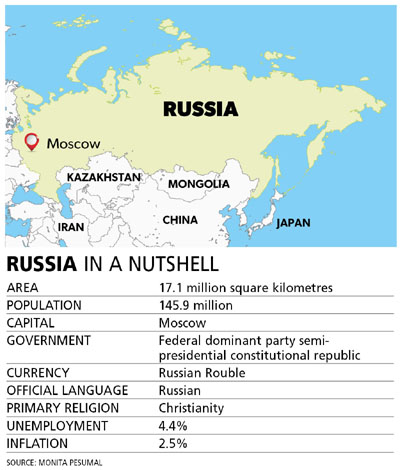RUSSIA TODAY
PUTIN’S SPHERE OF CONTROL
Monita Pesumal evaluates the present-day economic climate in the world’s largest nation state
 In March 2000, Vladimir Putin won the Russian presidential election and asserted control over the nation. Two decades and four presidential terms later, he continues to be in control. Putin is known for playing his political and popularity cards right, for within months of clinching his fourth term in office, Russia hosted the 2018 FIFA World Cup.
In March 2000, Vladimir Putin won the Russian presidential election and asserted control over the nation. Two decades and four presidential terms later, he continues to be in control. Putin is known for playing his political and popularity cards right, for within months of clinching his fourth term in office, Russia hosted the 2018 FIFA World Cup.
The competition went off smoothly with fans and teams alike praising their Russian hosts for putting on a grand show.
Today, Russia is the 11th largest economy in the world. The 1990s were considered a rough patch for the economy after it inherited a depleted industrial and agricultural sector – remnants of a centrally planned economy. After the millennium, Russia witnessed growth at a healthy pace of seven percent, led by a commodity boom.
The Kremlin’s dependence on oil came to the fore during the global financial crisis of 2007/08 and again in 2014. And the situation worsened with the imposition of sanctions by the West following Russia’s invasion of Crimea.
Russia’s economy has since grown at a steady pace thanks to petroleum price hikes until recently, achieving 1.3 percent growth in 2019. But due to COVID-19 and the economic picture growing dimmer by the day, economists at the IMF predict the Russian economy will contract by 5.5 percent this year.
Because the novel coronavirus pandemic is unprecedented and there’s no history to go by with regard to data, the appropriate term to use in this context would be that most economists and analysts can only ‘guess’ rather than predict. Measures to fight the coronavirus outbreak are expected to cost Russia 2.8 percent of its GDP, according to officials. The Central Bank of Russia has indicated that it could cut key interest rates, which presently stand at six percent, and that the economy is likely to contract in 2020 given the dual impact of the coronavirus outbreak and slump in oil prices.
Indeed, the price of oil has slumped to slightly less than half of what it was two months ago. Defined as a ‘petro economy,’ oil and gas make up two-thirds of Russia’s exports and this has caused the rouble to slide. The currency has lost nearly a third of its value since early January.
At the time of going to press, Brent crude – which is the benchmark for world oil prices – was valued at around US$ 36 a barrel.
America blames its record low US benchmark oil price of 34 dollars a barrel on the Kingdom of Saudi Arabia and Russia.

But US President Donald Trump recently managed to broker an agreement between OPEC and Russia to limit production. According to the Wall Street Journal (WSJ), OPEC and Russia were scheduled to cut production to 8.5 million barrels a day in May and June in a bid to try and phase off the gap between supply and demand.
Russia’s TASS news agency quoted Finance Minister Anton Siluanov stating that if oil prices were to remain at prevailing levels, Russia would have ample reserves until 2024. The Russian National Wealth Fund is expected to be worth RUB 7 trillion by the end of 2020, accounting for all planned spending. The sovereign wealth fund stood at 12.9 trillion roubles at the beginning of April. In this context, let’s also keep in mind that last year, the Russian government launched a EUR 390 billion plan to overhaul its economy by 2024, at the end of what should be Putin’s final term in office.
This investment plan features 13 national projects and follows the ‘May Decrees’ signed by Putin following his reelection in 2018, whereby he pledged to cut poverty in half and boost the economy substantially.
A quarter of the money has been reserved to revamp the country’s main infrastructure. Roads and safety will account for the second highest chunk of state expenditure at almost RUB 5 trillion with ecology rounding up the top three.
The digital economy will also undergo a transformation under this programme as one of the objectives is to ensure that at least 90 percent of the software used by government institutions and 70 percent used by state run organisations is Russian made.
Russia also wants to break into the foreign education market by becoming one of the world’s 10 leading countries for education in the future.
As far as the coronavirus pandemic goes, the Russian president has maintained that COVID-19 is under control. But while the situation in Moscow – the epicentre of the virus in Russia – appears to be stabilising, infections are growing outside the capital. The number of infections in Russia at the time of going to press was in excess of 360,000.
Initially, Russia was slow to recognise and take measures to contain the coronavirus pandemic. Putin first addressed the Russian people about the pandemic only on 25 March, telling them that Russia could not stop the disease from “spilling over” into the country.
Furthermore, he announced a paid non-working period that was extended until 30 April in an attempt to contain the spread of the deadly virus in Russia. The Russian president cautioned at the time: “Trust me, the best thing to do now is stay home.”



